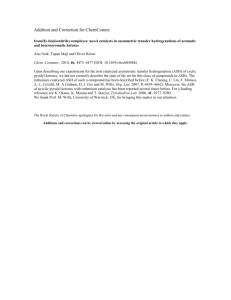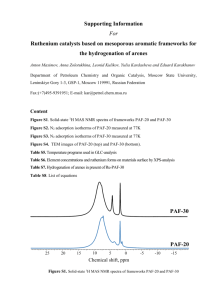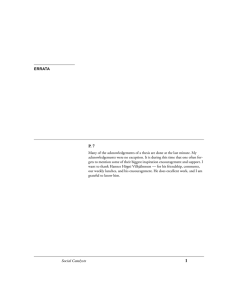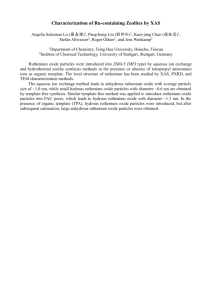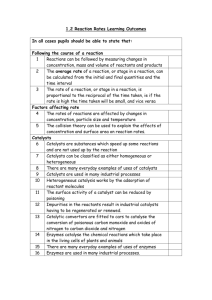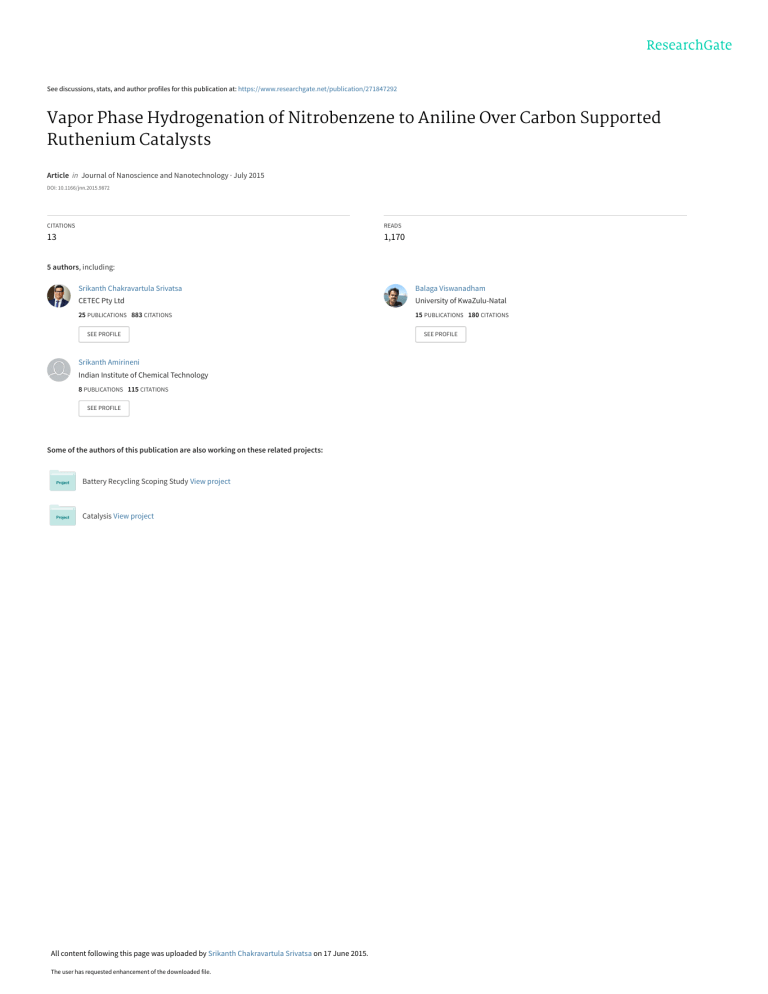
See discussions, stats, and author profiles for this publication at: https://www.researchgate.net/publication/271847292 Vapor Phase Hydrogenation of Nitrobenzene to Aniline Over Carbon Supported Ruthenium Catalysts Article in Journal of Nanoscience and Nanotechnology · July 2015 DOI: 10.1166/jnn.2015.9872 CITATIONS READS 13 1,170 5 authors, including: Srikanth Chakravartula Srivatsa Balaga Viswanadham CETEC Pty Ltd University of KwaZulu-Natal 25 PUBLICATIONS 883 CITATIONS 15 PUBLICATIONS 180 CITATIONS SEE PROFILE Srikanth Amirineni Indian Institute of Chemical Technology 8 PUBLICATIONS 115 CITATIONS SEE PROFILE Some of the authors of this publication are also working on these related projects: Battery Recycling Scoping Study View project Catalysis View project All content following this page was uploaded by Srikanth Chakravartula Srivatsa on 17 June 2015. The user has requested enhancement of the downloaded file. SEE PROFILE Article Journal of Nanoscience and Nanotechnology Copyright © 2014 American Scientific Publishers All rights reserved Printed in the United States of America Vol. 14, 1–7, 2014 www.aspbs.com/jnn Vapor Phase Hydrogenation of Nitrobenzene to Aniline Over Carbon Supported Ruthenium Catalysts Chakravartula S. Srikanth, Vanama Pavan Kumar, Balaga Viswanadham, Amirineni Srikanth, and Komandur V. R. Chary∗ Catalysis Division, Indian Institute of Chemical Technology, Hyderabad, India A series of Ru/Carbon catalysts (0.5–6.0 wt%) were prepared by impregnation method. The catalysts were characterized by X-ray diffraction (XRD), transmission electron microscopy (TEM), temperature programmed reduction (TPR), X-ray photoelectron spectroscopy (XPS), CO-chemisorption, surface area and pore-size distribution measurements. The catalytic activities were evaluated for the vapor phase hydrogenation of nitrobenzene. The dispersion measured by CO-uptake values suggests that a decrease of dispersion is observed with increasing Ru loading on carbon support. These findings are well supported by the crystallite size measured from XRD measurements. XPS study reveals the formation of Ru0 after reduction at 573 K for 3 h. The catalysts exhibit high conversion/selectivity at 4.5 wt% Ru loading during hydrogenation reaction. The particle size measured from CO-chemisorption and TEM analysis are related to the TOF during the hydrogenation reaction. Ru/C catalysts are found to show higher conversion/selectivities during hydrogenation of nitrobenzene to aniline. Keywords: Activated Carbon, Ruthenium Catalysts, Hydrogenation of Nitrobenzene and Active Sites. 1. INTRODUCTION Aniline is a valuable chemical for the plastics, rubber processing, herbicides, dyes and pigments industries. About 85% of global aniline is produced by catalytic hydrogenation of nitrobenzene. Supported metal catalysts are widely being used in various organic transformation reactions, especially hydrogenation. The supported metal systems are usually characterized by several techniques to measure metal dispersion and its availability since the activity and selectivity of hydrogenation reaction depends on them. Recently, carbon nanotube supported platinum catalyst,1 platinum nano-particle core-polyaryl ether trisacetic acid ammonium chloride dendimer shell nano-composites,2 Pd/active carbon,3 Pt/C catalysts in supercritical carbon dioxide and ethanol,4 Pd supported on hydrotalcite catalysts5 and Pd-B/SiO2 amorphous catalyst6 are used for nitrobenzene hydrogenation. Among supported noble metal catalysts, ruthenium is one of the most frequently ∗ Author to whom correspondence should be addressed. J. Nanosci. Nanotechnol. 2014, Vol. 14, No. xx used metal for hydrogenation reactions at laboratory level as well as industrial scale.7–11 Ruthenium has been used as the most promising catalyst7 in partial hydrogenation of benzene to cyclohexene. Ru is well known as very active catalyst for the hydrogenation of CO to hydrocarbons8 and ammonia synthesis.9 Ruthenium is very selective in hydrogenation of C O group in the vicinity of conjugated or isolated double bonds or an aromatic ring.10 11 Literature reports suggest that hydrogenation of nitrobenzene produces aniline along with several intermediates such as hydrazobenzene, azobenzene, azoxybenzene, nitrosobenzene and phenylhydroxylamine.4 However, on Ru/SBA-15 catalysts in our earlier report showed the selectivity for the formation of aniline was 100%.12 Due to its wide spread utility of Ru in hydrogenation reactions in this present work we used Ru/C catalysts for the hydrogenation of nitrobenzene. The catalytic activity results were discussed in terms of characteristics such as Ru particle size and metal dispersion. The catalysts were also characterized by an array of complimentary spectroscopic and adsorption techniques like BET surface area, pore size distribution, XRD, TEM, TPR and CO chemisorption. 1533-4880/2014/14/001/007 doi:10.1166/jnn.2014.9872 1 Vapor Phase Hydrogenation of Nitrobenzene to Aniline Over Carbon Supported Ruthenium Catalysts 2. EXPERIMENTAL DETAILS 2.1. Preparation of Catalyst Activated carbon of commercial origin (NORIT, BET surface area = 1340 m2 /g, crushed and sieved to 18/25 BSS) was used as a support material for synthesizing Ru/activated carbon catalysts. A series of ruthenium catalysts with different ruthenium loadings (0.5 to 6 wt%) were prepared by simple wet impregnation method using aqueous solution of RuCl3 on activated carbon support. The samples were dried at 383 K for 12 h in air. Prior to the catalyst characterization the catalysts are reduced under pure H2 flow (50 ml/min) at 573 K for 3 h. 2.2. X-Ray Diffraction Studies X-ray diffraction patterns were obtained on Rigaku miniflex diffractometer using graphite filtered Cu K (K = 0.15406 nm) radiation. Determination of the ruthenium phase was made with the help of JCPDS data files. 2.3. TEM Analysis The morphological analysis was carried out using transmission electron microscopy (TEM) on a JEOL 100S microscope at high resolution (HR) on a JEOL 2010 microscope). Samples for both TEM analysis were prepared by adding about 1 mg of pre-reduced sample to 5 mL of methanol followed by sonication for 10 min. A few drops of suspension were placed on a hollow copper grid coated with a carbon film made in the laboratory. 2.4. BET Surface Area and Pore Size Distribution The surface area, pore size distribution studies of the pre-reduced catalysts was estimated using N2 adsorption isotherms at 77 K by the multipoint BET method taking 0.0162 nm2 as its cross-sectional area using Autosorb-1 (Quanta chrome instruments). 2.5. Temperature Programmed Reduction (TPR) Temperature programmed reduction (TPR) experiment were carried out on Auto Chem 2910 (Micromeritics, USA) instrument. In a typical experiment ca. 100 mg of oven dried Ru/C sample (dried at 383 K for 12 h) was taken in a U-shaped quartz sample tube. Prior to TPR studies the catalyst sample was pretreated in an inert gas (Argon, 50 mL/min) at 473 K. After pretreatment, the sample was cooled to ambient temperature and the carrier gas consisting of 5% hydrogen balance argon (50 mL/min) was allowed to pass over the sample raising the temperature from ambient to 673 K heating at the rate of 10 K/min. The HCl produced during the reduction was condensed in a cold trap immersed in liquid nitrogen and isopropanol slurry. The hydrogen concentration in the effluent stream was monitored with the TCD and the areas under the peaks were integrated using GRAMS/32 software. 2.6. CO-Chemisorption CO-chemisorptions measurements were carried out on AutoChem 2910 (Micromeritics, USA) instrument. Prior 2 Srikanth et al. to adsorption measurements, ca. 100 mg of the sample was reduced in a flow of hydrogen (50 mL/min) at 673 K for 3 h and subsequently passed with pure helium gas flow for an hour at 673 K. The sample was subsequently cooled to ambient temperature in the same He stream. CO uptake was determined by injecting pulses of 9.96% CO balanced helium from a calibrated on-line sampling valve into the helium stream passing over the reduced samples at 673 K. Ruthenium surface area, percentage dispersion and Ru average particle size were calculated assuming the stoichiometric factor (CO/Rus ) as 1. Adsorption was deemed to be complete after three successive runs showed similar peak areas. 2.7. X-Ray Photoelectron Spectroscopy X-ray photoelectron spectroscopy was used to study the chemical composition and oxidation state of catalyst surfaces. The XPS spectra of the catalysts were measured on a XPS spectrometer (Kratos-Axis 165) with Mg K radiation (h = 12536 eV) at 75 W. The Ru 3d and 3p corelevel spectra were recorded and the corresponding binding energies were referenced to the C 1s line at 284.6 eV (accuracy within (0.2 eV)). The background pressure during the data acquisition was kept below 10−10 bar. 2.8. Catalytic Activity Studies Hydrogenation of nitrobenzene (C99.9% Aldrich chemicals) was carried out over the catalysts in a vertical down-flow glass reactor at 548 K and operating under atmospheric pressure. Ca. 100 mg of the catalyst, diluted with double the amount of quartz grains was packed between the layers of quartz wool. The upper portion of the reactor was filled with glass beads, which served as pre-heater for the reactants. Prior to the reaction, the catalyst was reduced in a flow of hydrogen (50 mL/min) at 573 K for 3 h. After reduction the reactor was fed with nitrobenzene at 523 K (WHSV = 3612 h−1 ; H2 /Nitrobenzene = 4; Residence time: 0.0276 h). The reaction products were analyzed by HP-6890 gas chromatograph equipped with a HP-5 capillary column with a flame-ionization detector (FID). The products were also identified using HP-5973 quadrupole GC-MSD system using HP-1MS capillary column. 3. RESULTS AND DISCUSSION 3.1. X-Ray Diffraction Figure 1 shows the XRD patterns of pure activated carbon and different loadings of ruthenium supported on activated carbon catalysts exhibited no peaks due to Ru except 6.0 wt% Ru/C catalysts corresponding to Ru (110) plane.12 13 The Ru/C catalyst showed an increase in the intensity of the broad peak centered at 2 = 44 , from 3 wt% Ru catalyst characteristic of amorphous metallic ruthenium species.14 This clearly indicates the formation J. Nanosci. Nanotechnol. 14, 1–7, 2014 Srikanth et al. Vapor Phase Hydrogenation of Nitrobenzene to Aniline Over Carbon Supported Ruthenium Catalysts Ru Wt% Intensity(a.u.) 6.0 4.5 3.0 1.5 0.5 Activated carbon 10 20 30 40 50 60 70 80 2 Theta Figure 1. X-ray diffraction patterns of Ru/C catalysts. of Ru0 due to reduction of catalysts at 573 K in pure H2 flow prior to the XRD analysis. We could observe an XRD peak a 2 = 694 for 6.0 wt% ruthenium loading.12 13 The catalysts with 3 wt% Ru loading also showed a broad reflection at 2 = 694 indicating the presence of crystalline Ru. However, the same was not observed in 4.5 wt% catalysts; hence the peak in 3 wt% catalysts is attributed as artifact of the instrument. The absence of XRD reflections corresponding to crystalline Ru0 in the present catalytic system suggests that the high dispersion of metallic ruthenium on carbon support. However, it cannot be ruled out the presence of Ru0 crystallites having size less than 4 nm, which is beyond the detection limit of powder XRD technique. This implies that the smaller metal crystallites either interacts strongly with the support surface or get immobilized in to the high surface area of the activated carbon support. 3.2. Transmission Electron Microscopy Figure 2 shows the morphology of Ru supported on activated carbon catalyst, investigated by the transmission electron microscopy (TEM). The micrographs of 0.5 wt% Ru/C shows no visible images for the presence of Ru on the carbon support, which suggest the presence of Ru particles as highly dispersed state in amorphous form. This clearly indicates that Ru at lower loadings is present in highly dispersed state with very small particle sizes or immobilized into the porous network of the carbon support. The TEM image of 3.0 and 6.0 wt% catalyst show that the uniform distribution of larger number of small ruthenium particles. These results clearly suggest the highly dispersed state of ruthenium at lower Ru loadings and with increasing Ru content the particle size is increased. The presence of larger number of smaller particle of ruthenium agrees well with the absence of Ru particle below 4.5 wt% of Ru on activated carbon support in XRD. 3.3. BET Surface Area and Pore Size Distribution The surface areas determined by nitrogen physisorption for pure carbon and various Ru/C catalysts are given in Table I. The BET surface area of the pure carbon was found to be 1340 m2 /g. Impregnation of Ru on the carbon decreased the surface area of the support which can be attributed to filling of the pores of the support evidenced by the pore diameter and pore volume measurements. Figure 3(a) show the nitrogen adsorption/desorption isotherm and 3(b) show the Barrett Joyner Halenda (BJH) pore size distribution of Ru/activated carbon catalysts. The pure activated carbon support shows the presence of both micro and mesorporus nature with the average pore diameters in the range of ∼ 15 and ∼ 50 Å. The presence of micropores can be observed by the presence of shoulder peak at 20 Å, however not able to measure in the present system. The addition of Ru to carbon has no significant effect on the isotherms and pore size distribution. The pure activated carbon support shows the presence of both micro and mesorporus nature with the average pore diameters in the range of ∼ 15 and ∼ 36 Å. The addition of Ru to carbon has a significant effect on the isotherms and pore size distribution. A well-defined step occurs in P /P0 range of 0.4–0.5 represents the spontaneous filling of the mesopores due to capillary condensation, which is also evidenced by the BJH distribution Figure 3(b). The amount of physisorbed nitrogen decreased at the higher loading of Ru on activated carbon support. The intensity of pore size distribution peak 3(b) decreases with increase of Ru loading due to the presence of Ru particles inside the pores of activated carbon. The results of BET surface area and pore volume of the sample decrease after impregnation of Ru onto the activated carbon are showed Figure 2. TEM images of various Ru/C catalysts. J. Nanosci. Nanotechnol. 14, 1–7, 2014 3 Vapor Phase Hydrogenation of Nitrobenzene to Aniline Over Carbon Supported Ruthenium Catalysts Srikanth et al. Table I. Results of ICP analysis and BET surface area of various ruthenium supported on carbon. Ru loading (wt%) Ru (ICP) loading (wt%) BET surface area (m2 /g) Total pore volume (mL/g) Average pore diameter (Å) — 0.38 1.24 2.60 4.26 5.74 1340 1322 1322 1288 1233 1209 0.883 0.874 0.861 0.842 0.778 0.732 26.48 26.25 25.98 25.77 25.33 24.22 0.0 0.5 1.5 3.0 4.5 6.0 in Table I. The decrease in surface area and pore volume are attributed to the intra-pore formation of the ruthenium nano-particles within the pores reduces the surface area and pore volume. The introduction of metallic elements onto activated carbon decreases the surface area can be also ascribed to an increase in the density of the composites after loading of ruthenium. 3.4. Temperature Programmed Reduction The reducibility of ruthenium species in Ru/C catalysts with different ruthenium loading was investigated by the temperature programmed reduction (TPR) method and the profiles are shown in Figure 4. All the samples show a main reduction peak around 450–480 K with a shoulder at lower reduction temperature. This can be assigned to the stepwise reduction of Ru3+ /Ru0 .12 15–17 This peak is broad, (a) Ru wt% 6.0% Volume (cc/g) 4.5% 3.0% 1.5% 3.5. CO Chemisorption The dispersion of Ru was calculated from COchemisorption using the following equation assuming the 0.5% 0.0% 0.0 0.2 possibly due to the reduction of Ru3+ ions located in different environments. However, this peak is less intense and is shifted to lower reduction temperatures (426–411 K) at higher loadings. The Ru/C catalysts with 4.5 and 6.0 wt% the main reduction peak is more intense, possibly due to the poor dispersion of the ruthenium salt in this solid, leading to the formation of bigger particles where the diffusion of H2 is more difficult, and thus appearing at higher temperatures (> 460 K). The third H2 consumption peak appears at around 540–510 K, which could be assigned to the reduction of Ru3+ strongly interacting with the support. This high temperature peaks can also possibly associated with to the reduction of Ru present in the narrowest pores or reduction of ruthenium oxide (RuO2 ) or ruthenium oxychloride formed by exposition and drying in air during the preparation of the samples.12 18 The positions of Tmax and the H2 consumptions are presented in the Table II showed slightly high amounts than the amount of metal precursor present on the support. The excess H2 consumption might be due to the reduction of oxygen containing groups present on the carbon support.19 0.4 0.6 0.8 1.0 Relative pressure (p/p0) (b) Ru wt% Pore volume (cc/g) 6.0% 4.5% 3.0% 1.5% 0.5% Activated Carbon 20 40 60 80 100 120 140 160 Pore Diameter (Å) Figure 3. (a) N2 adsorption–desorption isotherms (b) BJH pore size distribution of pure carbon support and Ru/C catalysts. 4 Figure 4. catalysts. Temperature programmed reduction profiles of various Ru/C J. Nanosci. Nanotechnol. 14, 1–7, 2014 Srikanth et al. Vapor Phase Hydrogenation of Nitrobenzene to Aniline Over Carbon Supported Ruthenium Catalysts Table II. Temperature programmed reduction results of various Ru/C catalysts. Ru wt% 0.0 0.5 1.5 3.0 4.5 6.0 1 Tmax (K) H2 uptake (mol/g) 2 Tmax (K) H2 uptake (mol/g) 3 Tmax (K) H2 uptake (mol/g) Total H2 uptake (mol/g) — – – 426 411 409 – – – 277.4 367.0 450.5 433 460 467 473 475 478 85.5 134.7 371.2 554.5 740.6 901.5 – – 543 521 515 513 – – 25.0 166.4 178.4 187.4 85.5 134.7 396.2 998.3 1286.0 1539.4 cubic particle with five sides exposed to the gas plane, %Dispersion = (number of surface Ru atoms × 100/ Total number of Ru atoms Average particle size (nm) = 6000/Ru metal area per gram of Ru × Ru density The ruthenium metal areas were determined using the equation SCO = nmS Xm ns−1 , where SCO is the total metallic surface area, nmS is the CO consumption and Xm is chemisorptions stoichiometry at monolayer coverage, and ns−1 is the number of ruthenium atoms per unit surface area. The results of CO-chemisorption dispersion, metal area and particle size are presented in Table III. Dispersion of ruthenium on activated carbon varied from 84.3% to 23.8% for 0.5 to 6.0 wt% ruthenium loading. The high dispersion of ruthenium at lower loadings of ruthenium is probably attributed to strong interaction of ruthenium with the oxygen containing groups of activated carbon. It is likely that as Ru content increases; the deposition may be more on the external surface of the carbon support. This will reduce the distance between metallic species, thereby promoting agglomeration leading to the decrease in dispersion of Ru. The results showed that irreversible CO uptakes and number of active sites increases up to 4.5 wt% and decrease slightly at 6.0 wt% ruthenium on activated carbon. The particle size of ruthenium also increases linearly up to 4.5 wt% and exponentially at 6.0 wt%. The results suggest that ruthenium is present in highly dispersed form at lower loadings and agglomerization takes place at higher loadings. The results of CO-chemisorption are in good agreement with the results of XRD and TEM where the increase in the particle size was observed only at 6 w% Ru/C catalysts. 3.6. X-Ray Photoelectron Spectroscopy Table IV presents the information obtained from XPS results such as the binding energy values of C 1s, its FWHM values, deconvoluted binding energies of C 1s and its ratio. All the catalysts are showing the C 1s binding energy values around ∼ 284.8 eV. The binding energy of 284.8 eV is well fit with the corresponding binding energy of carbon. With increase of ruthenium loading there is a slight shift in the C 1s B.E values towards lower energy. However, the decrease in binding energy of C 1s, might be due to decrease of ruthenium dispersion i.e., interaction between the metal and the support decreased. The constant FWHM values are around 1.8, implying that only Table III. Results of CO chemisorption dispersion and metal area on various Ru/C catalysts. Ru loading (wt%) 0.5 1.5 3.0 4.5 6.0 Dispersion (%) COirr uptake (mol/g) Metal area (m2 /gRu ) Metal area (m2 /gcat ) No. of Ru sites g(cat)−1 (x1019 Particle size (nm) 84.3 73.3 50.0 35.3 23.8 48.6 108.8 148.1 157.0 141.4 478.6 357.2 243.3 172.1 116.0 2.39 5.53 7.30 7.74 6.95 2.92 6.55 8.92 9.45 8.51 1.0 1.3 2.0 2.8 4.2 Table IV. Binding energies (eV), FWHM of Ru 3p and deconvoluted BE and its ratio of C 1s of Ru/C catalysts. BE (eV) C 1s (deconvoluted) Ru loading (wt%) 0.5 1.5 3.0 4.5 6.0 BE (eV) and FWHM of C 1s 284.8 284.8 284.8 284.7 284.7 (1.8) (1.8) (1.7) (1.9) (1.9) CC–O CC–C 284.3 284.4 284.4 284.4 284.4 (60)∗ (60) (61) (62) (61) 285.8 285.7 285.7 285.7 285.7 Notes: ∗ Corresponding to % of peak; # corresponding to FWHM values C oxygen groups. J. Nanosci. Nanotechnol. 14, 1–7, 2014 (40)∗ (40) (39) (38) (39) Ratio of CC–C /CC–O 1.25 1.25 1.56 1.63 1.56 BE (eV) and FWHM of Ru 3d5/2 463.0 463.2 463.4 463.5 463.5 C corresponding to carbon bonded with carbon; C (1.8) (1.9) (2.1) (2.2) (2.4) BE (eV) and FWHM of Ru 3d3/2 483.7 483.9 484.0 484.1 484.2 (0.8) (1.1) (1.2) (1.2) (1.3) O corresponding to carbon bonded with 5 Vapor Phase Hydrogenation of Nitrobenzene to Aniline Over Carbon Supported Ruthenium Catalysts one type of doublet is present. According to the literature14 the peaks of C 1s deconvolution can be ascribed to carbon atoms bonded to the following functionalities. The carbon in graphite at ∼ 284.4 eV (CC–C ), carbon would be linked to ketone, quinine at 287.5 (Cc o) hydroxyl and phenol groups have peak at ∼ 286.5 eV (CC–O ). These results clearly demonstrated that the activated carbon is formed in a frame like morphology containing different oxygen functional groups. The ratio of the carbon bonded to carbon and the carbon bonded to oxygen is increasing with increase of ruthenium loading, which might be due to formation bonding between ruthenium and oxygen (Ru–O) or coverage of ruthenium on oxygen containing carbon surface. The intensity of C 1s core level spectra does not change much with the increase of ruthenium loading. Figure 5 shows the XPS spectrum of Ru 3p regions of Ru/AC, catalysts, indicating the electronic state and the environment of Ru species present in supported catalysts. The binding energies and their FWHM values are reported in Table IV. Ru 3p signals were considered instead of 3d, due to overlaps of Ru 3d signal with C 1s signal which created ambiguity in determining the exact oxidation state of ruthenium.20 Generally Ru0 possesses binding energy values in the range of 462–463 eV. The 3p signal of Ru shows a doublet at B.E. (3P3/2 ) 462.8 and (3P5/2 ) 484.3 (eV), which are characteristic of Ru0 .12 16 The B. E. (462.8) of Ru 3p signal at 3p3/2 remained constant in all loadings showing the absence of any specific interaction between the metal and support. The intensity of XPS peak corresponding to 3p5/2 increases with ruthenium loading on carbon support. Further, the XPS analysis did not shown any signal for the presence of residual chloride after reduction of the catalyst samples at 573 K for 3 h, prior to the analysis. This further confirms the absence of any surface Cl species.12 TPR results also show that the reduction of the Srikanth et al. catalysts was complete before 573 K indicating complete reduction of ruthenium to its metallic state (Ru0 ). 3.7. Hydrogenation of Nitrobenzene Figure 6 shows the results for the effect of ruthenium loading in the hydrogenation of nitrobenzene to aniline on carbon support at 548 K. The conversions of nitrobenzene to aniline increased with ruthenium loading up to 4.5 wt% and leveled off at 6 wt% Ru catalysts. The leveling off of the hydrogenation activity at higher loadings is can be attributed to increase in the particle size of ruthenium particles at higher loadings.21 22 The conversion of 0.5 wt% ruthenium loading was 20% increases up to 90% as the ruthenium loadings increase up to 4.5 wt%. The selectivity for the formation of aniline remained > 99% for all the catalysts with trace amounts of benzene formation. The CO-uptake values also increased up to 4.5 wt% and showed a slight decrease at 6 wt% higher ruthenium loading. No. of surface active sites also decreased at higher loading due to agglomerization of Ru particles. Figure 7 show the relationship between TOF and particle size of Ru/C catalysts for the hydrogenation of nitrobenzene to aniline. TOF is defined as the rate of nitrobenzene molecules converted per unit time per exposed site of ruthenium. The TOF’s are calculated form chemisorption data as the number of molecules of nitrobenzene converted by one surface Ru atom per second using following equation: Rate = Volume of reactant fed × Fractional conversion/weight of the catalyst TOF = Rate/CO − uptake The correlation in Figure 7 suggests that structure-activity relationship exists between ruthenium dispersion and hydrogenation activity. The TOF increased with increase % Conversion/Selectivity 100 90 80 70 60 50 40 Conversion of nitrobenzene 30 Selectivity for aniline 20 10 0 0 1 2 3 4 5 6 Ru loading (Wt%) Figure 5. Ru 3p XPS spectra of various Ru/C catalysts. 6 Figure 6. Hydrogenation of nitrobenzene to aniline over Ru/C catalysts reaction conditions: weight of the catalyst = 100 mg; reaction temperature = 548 K; WHSV = 3612 h-1; H2 /Nitrobenzene = 4; residence time: 0.0276. J. Nanosci. Nanotechnol. 14, 1–7, 2014 Srikanth et al. Vapor Phase Hydrogenation of Nitrobenzene to Aniline Over Carbon Supported Ruthenium Catalysts TOF results suggest that the activity of the catalysts is dependent of the particle size of ruthenium and the reaction is found to be structure sensitive. 5 4.8 3 4.0 2 3.6 TOF Particle size Particle size (nm) TOF x 10–4(s–1) 4 4.4 1 3.2 0 1 2 3 4 5 6 Ru loading (wt%) Figure 7. Correlation between turn over frequency, particle size and Ru loading over Ru/C catalysts. of ruthenium loading up to 4.5 wt%, and less significant beyond this loading. There is a substantial change of per site activity (TOF) with respect to the Ru particle size. This suggests that there is structure-sensitive nature of the reaction over ruthenium supported on activated carbon catalysts. The increase in hydrogenation activity with Ru loadings on Ru/C catalysts is probably due to a high dispersion of Ru and the constant activity at higher loadings is due to formation of Ru particle. These catalytic results are in good agreement with the results of dispersion, and the information derived from XRD and TEM. 4. CONCLUSIONS The results of TEM suggest that ruthenium is highly dispersed on the carbon support up to 4.5 wt% and formed large particles at 6 wt% which is good agreement with CO-chemisorption data. TPR results showed that reduction of RuCl3 takes place in two steps and the reduction is complete by 573 K. XPS results showed the formation of Ru0 species and absence of chloride ions in the catalysts after reducing 573 K and for 3 h. High dispersion of Ru can be achieved on carbon support below 4.5 wt% of Ru. Catalytic activity for the hydrogenation of nitrobenzene to aniline on Ru/C catalysts showed optimum activity obtained at 4.5 wt%. Selectivity for the formation of aniline was found to be > 99% for all the catalysts tested. Acknowledgments: The authors thank Director, IICT, Hyderabad for her encouragement. References and Notes 1. C. H. Li, Z. X. Yu, K. F. Yao, S. Ji, and J. Liang, J. Mol. Cat. A: Chem 226, 101 (2005). 2. P. Yang, W. Zhang, Y. Du, and X. Wang, J. Mol. Cat. A: Chem 260, 4 (2006). 3. N. Bouchenafa-Saib, P. Grange, P. Verhasselt, F. Addoun, and V. Dubois, Appl. Cat. A: Gen. 286, 167 (2005). 4. F. Zhao, Y. Ikushima, and M. Arai, J. Catal. 224, 479 (2004). 5. P. Sangeetha, P. Seetharamulu, K. Shanthi, S. Narayanan, and K. S. Rama Rao, J. Mol. Catal. A: Chem. 273, 244 (2007). 6. X. Yu, M. Wang, and H. Li, Appl. Catal. A: Gen. 202, 17 (2000). 7. J. Bu, Y. Pei, P. Guo, M. Qiao, S. Yan, and K. Fan, Stud. Surf. Sci. Catal. 165, 769 (2007). 8. P-Z. M. Josefina, D. Muriel, H. Yann, G. Anne, L. Lucien, L. Ginette, G. Mireya, C. M. Luisa, and B. Geoffrey, Appl. Catal. A: Gen. 274, 295 (2004). 9. B. Lin, R. Wang, J. Lin, S. Du, X. Yu, and K. Wei, Catal. Comm. 8, 1838 (2007). 10. J. Hajek, N. Kumar, P. Maki-Arvela, T. Salmi, and D. Yu. Murzin, J. Mol. Catal. A: Chemical 217, 145 (2004). 11. N. Kumar, P. Maki-Arvela, J. Hajek, T. Salmi, D. Yu. Murzin, T. Heikkila, E. Laine, P. Laukkanen, and J. Vayrynen, Micropor. Mesopor. Mater 69, 173 (2004). 12. K. V. R. Chary and C. S. Srikanth, Catal. lett. 128, 164 (2009). 13. J. Barbier, J. Catal. 177, 378 (1998). 14. D. S. Lee and T. K. Liu, J. Non-Cryst. Solids 311, 323 (2002). 15. P. Betancourt, A. Rives, R. Hubaut, C. Scott, and J. Goldwasser, Appl. Catal. A: Gen. 170, 307 (1998). 16. D. Eliche-Quesada, M. Macias-Ortiz, J. Jimenez-Jimenez, E. Rodriguez-Castellon, and A. Jimenez-Lopez, J. Mol. Catal. A: Chem. 255, 41 (2006). 17. F. Pinna, M. Signoretto, G. Strukul, A. Benedetti, M. Malentacchi, and N. Pernicone, J. Catal. 155, 166 (1995). 18. C. S. Srikanth, V. P. Kumar, B. Viswanadham, and K. V. R. Chary, Catal. Comm. 13, 69 (2011). 19. S. Kundu, Y. Wang, W. Xia, and M. Muhler, J. Phy. Chem. C 112, 16869 (2008). 20. T. Komanoya, H. Kobayashi, K. Hara, W. J. Chun, and A. Fukuoka, Appl. Catal. A: Gen. 409, 13 (2011). 21. S. Kataoka, Y. Takeuchi, A. Harada, T. Takagi, Y. Takenaka, N. Fukaya, H. Yasuda, T. Ohmori, and A. Endo, Appl. Catal. A: Gen. 433, 280 (2012). 22. V. Pavankumar, C. S. Srikanth, A. Nageswararao, and K. V. R. Chary, J. Nanosci. Nanotechnol. 14, 3137 (2014). Received: 5 March 2014. Accepted: 24 May 2014. J. Nanosci. Nanotechnol. 14, 1–7, 2014 View publication stats 7
